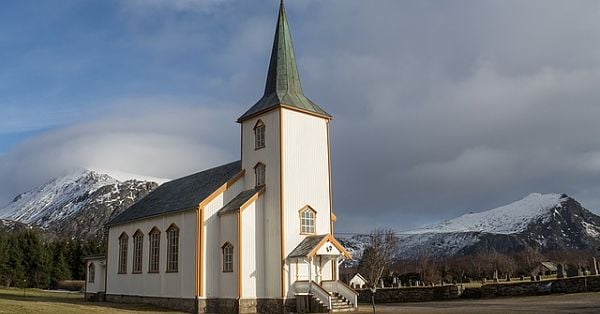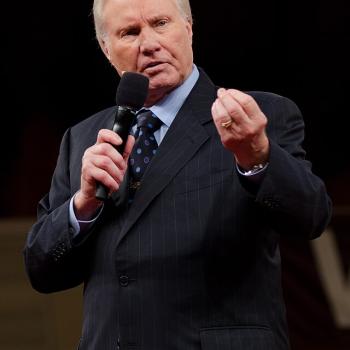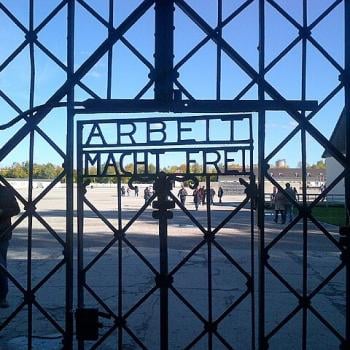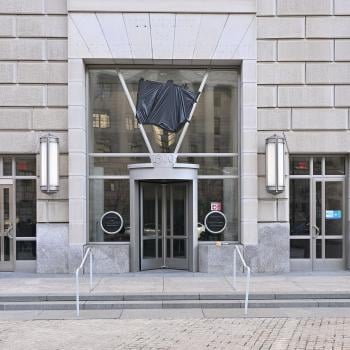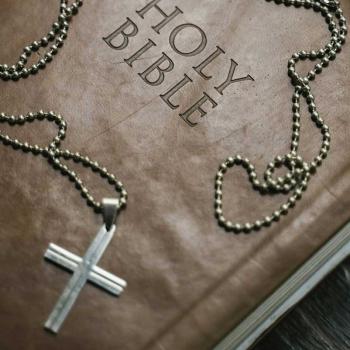My Religious Roots: A Pilgrimage
I rarely talk here about myself, but some of my faithful readers have asked me to do just that. They especially want to know more about my religious background and upbringing and my early religious influences. Here I bow briefly to their desires.
My first memories of church are of Pentecostal or “Full Gospel” services of all kinds in a tiny, very old, almost falling down, white clapboard church in the poorest neighborhood of the city where I was born in the Upper Midwest. About twenty years before I was born the city was visited by “Sister Aimee”—Aimee Semple McPherson—a celebrity Pentecostal healing evangelist. More about her later. The aftermath of her revival there lingered a very long time. Many Pentecostal churches were born out of it. Ours was one, although it was not part of her International Church of the Foursquare Gospel—the denomination she founded.
The leaders of our little Pentecostal “movement” or “fellowship” were her associate evangelists who broke away from her and founded their own. We were often reminded it was not a “denomination” but a “movement” and “fellowship.” It was a denomination and still exists.
I never dreaded church; church was exciting. You never knew what was going to happen. “Church” was on Sunday morning from about 9:00 until about noon and again from about 6:00 until whenever the Spirit stopped moving. I always took a pillow to church on Sunday evenings and slept on a pew as the Spirit stirred the people to sometimes boisterous prayers and praises into the night. Sunday evening service usually ended around 10:00, but sometime it would go until 11:00.
Then there were Tuesday and Thursday evening prayer and Bible study services. And there were “protracted meetings” or extended revivals both at our church and other churches that lasted a week or two. Then we went to church every evening.
My father was the pastor of our little church in “the Bottoms”—the shabbiest, poorest neighborhood in town—but there was another pastor of a larger church in a “swankier” part of town to whom everyone looked as our leading pastor. He was my father’s mentor and mentor to numerous pastors of our denomination (and possibly others). To my parents and everyone in our denomination he was a God-like figure. He had been somehow associated with Sister Aimee as had been other leaders of our denomination.
That “mother church” had been a Methodist Episcopal church until it become Foursquare and then our denomination’s mother church in about 1935. I remember attending many special services there and seeing on the high ceiling of the sanctuary the four hallmarks of the “Foursquare gospel”—Jesus as savior, healer, baptizer with the Holy Spirit, and coming king. (Sister Aimee seems to have borrowed that from A. B. Simpson, founder of the Christian Missionary Alliance.)
I cannot exaggerate the importance of church in our family life. There was no boundary between church, denomination, and home. It was all one. And it was a church, denomination, and home of poverty. Any disposable income was expected to go to world missions. The missionaries, including some of my aunts and uncles, were our saints. Their pictures adorned the walls of our home. When they came to the U.S. on “furlough” to “itinerary” to raise money they stayed in our home.
But, we were part of two larger movements—the Pentecostal or Full Gospel movement and the broader evangelical movement. My father was always active in the local evangelical ministerial alliance. We often attended special Christian ecumenical meetings and events at evangelical churches and camp meetings, conventions and conferences, that were not specifically Pentecostal. We loved our “close cousins” the Nazarenes and wished they spoke in tongues. Every summer my parents took me to the area-wide Nazarene camp meeting where the newest Southern gospel music was premiered by groups like the Speer Family. Emotions ran high there, but there was no speaking in tongues except my stepmother’s under her breath.
Youth for Christ was active in our city and our church was very much involved in YFC which usually met for all kinds of special evening events at First Covenant Church. YFC was transdenominational, a parachurch organization where young people met other young people from a wide variety of churches.
Some years ago I assigned each student in one of my classes to write up his or her own “religious history”—going as far back as possible using family histories. The exercise was a study of religious roots.
So here is mine in brief.
All of my ancestors—as far back as I can trace—were European Lutheran or Reformed. My birth mother’s ancestors lived in Southwest Germany and belonged to what in the United States came to be called the Evangelical and Reformed Church (which eventually merged with the American Congregational Churches to form the United Church of Christ). My great-great-grandparents came from the same town in Germany as Reinhold Niebuhr’s family and at the same time. Both families settled first in the same Illinois town and then went their separate ways from there. My mother, however, was raised in the Evangelical Free Church near where that denomination was founded by Swedish and Norwegian immigrants who were pietists. More about her later. My grandparents always belonged to the EvFree Church and their funerals were in it. My mother’s siblings were either that or became members of the similar Covenant Church.
My father’s parents immigrated to the United States from Norway and Denmark when they were children. In “the old countries” they were baptized Lutheran. However, when their parents settled on the empty prairies of eastern South Dakota the only church nearby was a Church of God (Anderson, Indiana)—a “Holiness” denomination that also claimed not to be a denomination but a movement. My paternal grandparents are buried in that church’s cemetery in the middle of nowhere. The church is now gone.
My father, however, was raised in a Pentecostal church after his family “lost the farm” in the Great Depression. They moved into a small city and there joined the tiny church of our denomination. Most of his aunts and uncles, however, stayed in the Church of God.
My father often testified that he was saved on May 16, 1943 at that tiny Pentecostal church which I visited numerous times as a child. He then moved to the city where I was born, attended “our” Bible college, and became pastor of our tiny Pentecostal/Full Gospel church in the Bottoms at the ripe old age of nineteen. There he met another graduate of the Bible college who had become Pentecostal at the “mother church” and taught Sunday School at the church my father pastored. The church’s congregation was the poorest of the poor and almost all immigrants to that city from the Ozarks.
Back then, in the 1950s, our denomination and ones like it were widely considered “cults” by mainstream Christians. But we were part of the National Association of Evangelicals. Many people called us “holy rollers” although I never saw anyone actually roll. But we did believe fervently in divine healing (not “faith healing”) and admired healing evangelists like William Branham and Oral Roberts and later Kathryn Kuhlman. There was much talk about “Sister Aimee” especially by those who knew her but I learned early that she was somewhat “scandalous.” The word “flamboyant” must have been invented for her! You can see her on Youtube. She died in the 1940s leaving behind a denomination much like ours but not ours.
Like other Pentecostal denominations we had women evangelists, church planters and even pastors. I grew up assuming that women could be ordained and pastor and preach. In other ways, however, we were fundamentalists. Everyone used the Scofield Reference Bible and we were premillennialism who believed in the “rapture” and fully expected that, in our lifetimes, the “Antichrist” would arise and Jesus Christ would return to defeat him. We specialized in eschatology (beliefs bout the end times).
We had no theologians; “theology” was considered a waste of time and a distraction. The highest and really only calling a young person could have and follow was to be an evangelist or missionary or church planter. When I decided to become a theologian I’m sure many prayers went put for me. People in our denomination almost never went to seminary. I was one of the first and that was the beginning of the end for me—in our denomination.
Recently I was reminded of all of this as I toured Angelus Temple in the Echo Park neighborhood of Los Angeles. That is the megachurch founded by Sister Aimee. Her parsonage next to the church is now a museum to her and her ministry. In a way I trace my spiritual roots back to her and to that church. Most of the founders of our denomination were at some time associated with it and with Sister Aimee.
I have read several biographies of Sister Aimee and watched documentaries about her. She was a feminist before feminism was a movement. Someone recently asked me how she got men to allow her to start her own church, her own denomination, her own radio station, her own Bible college and her own everything. I replied “She didn’t. She did it without them.” And yet, she is almost completely ignored by feminists when they talk or write about influential women of the past.
Yes, parts of her life were scandalous, but the facts are much debated. Like most great, influential, independent religious founders she was complicated. In the 1920s and into the 1930s she was one of America’s and the world’s best known religious celebrities—making headlines everywhere she went but especially in Los Angeles.
I have made it part of my mission as a church historian to teach about Aimee Semple McPherson and to fill in that gap in my students’ knowledge about women in religion.
So that is the story of my religious background in a nutshell. Of course, in my twenties I became Baptist but also taught at Oral Roberts University for two years in the 1980s. But that is for another blog post.
*Note: Here I speak only for myself. If you choose to respond be brief and civil. I will not post hostile comments here.


